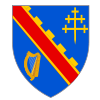Co. Armagh
|
County Armagh Contae Ard Mhacha
Coontie Airmagh/Coontie Armagh |
||
|---|---|---|
|
||
 |
||
| Country | United Kingdom | |
| Region | Northern Ireland | |
| Province | Ulster | |
| County town | Armagh | |
| Area | ||
| • Total | 512 sq mi (1,326 km2) | |
| Area rank | 27th | |
| Population (2011) | 174,792 | |
| • Rank | 11th | |
| Contae Ard Mhacha is the Irish name; Coontie Armagh and Coontie Airmagh are Ulster Scots spellings. | ||
County Armagh (named after its county town, Armagh) is one of six counties that form Northern Ireland. Adjoined to the southern shore of Lough Neagh, the county covers an area of 1,326 km² and has a population of about 174,792. It is within the historic province of Ulster. County Armagh is known as the "Orchard County" because of its many apple orchards. It is also one of the thirty-two traditional counties of Ireland, as well as part of the historic province of Ulster.
The name "Armagh" derives from the Irish word Ard meaning "height" and Macha, together meaning "height" (or high place) and Macha. Macha is mentioned in The Book of the Taking of Ireland, and is also said to have been responsible for the construction of the hill site of Emain Macha (now Navan Fort near Armagh City) to serve as the capital of the Ulaid kings (who give their name to Ulster), also thought to be Macha's height.
From its highest point at Slieve Gullion, in the south of the County, Armagh's land falls away from its rugged south with Carrigatuke, Lislea and Camlough mountains, to rolling drumlin country in the middle and west of the county and finally flatlands in the north where rolling flats and small hills reach sea level at Lough Neagh.
County Armagh's boundary with Louth is marked by the rugged Ring of Gullion rising in the south of the county whilst much of its boundary with Monaghan and Down goes unnoticed with seamless continuance of drumlins and small lakes. The River Blackwater marks the border with County Tyrone and Lough Neagh otherwise marks out the County's northern boundary.
...
Wikipedia

